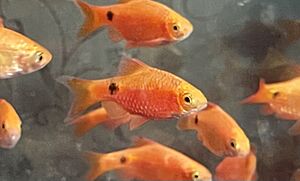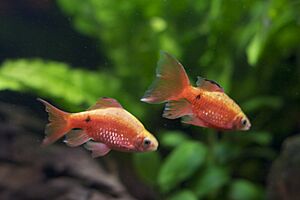Rosy barb facts for kids
Quick facts for kids Rosy barb |
|
|---|---|
 |
|
| Conservation status | |
| Scientific classification | |
| Synonyms | |
|
The rosy barb (Pethia conchonius) is a colorful freshwater fish. It belongs to the cyprinid family, which includes carps and minnows. You can find these fish in southern Asia, from Afghanistan all the way to Bangladesh. They are a popular choice for home aquariums because they are beautiful and easy to care for.
Contents
What Does a Rosy Barb Look Like?

Rosy barbs can grow up to about 6 inches (14 cm) long. Young fish have large, deeply forked tails. These tails look quite big compared to their bodies.
Their colors become much brighter when they are ready to mate. Male rosy barbs usually have more vibrant colors. Female rosy barbs are often a bit plumper. Also, males have some black color in their fins, but females do not.
When fully grown, they can weigh up to 12 ounces (340 grams). However, they often weigh much less when they are younger. They are ready to have babies when they are about 2.5 inches (63.5 mm) long.
Where Do Rosy Barbs Live?
In the wild, rosy barbs eat many different things. They are omnivores, meaning they eat both plants and animals. Their diet includes worms, insects, small crustaceans, and plant parts.
These fish can live for up to 5 years. Rosy barbs naturally live in lakes and rivers with fast-flowing water. They prefer a warm, subtropical climate. The water in their natural home usually has a pH between 6 and 8. The water hardness is between 5 and 19 dGH. The temperature ranges from 64 to 72 °F (18 to 22 °C).
Why Are Rosy Barbs Important to People?
Rosy barbs are very important in the pet fish trade. Many people buy them for their home aquariums. They are also sometimes used to create new types of "tiger barbs" by mixing them with other fish species.
Reproduction and Life Cycle
When a female rosy barb is ready to lay eggs, she will look swollen. The male fish will swim around and chase her. He will gently nudge her head and belly. This encourages her to lay her eggs.
Spawning, or laying eggs, usually happens early in the morning. It can last for several hours. A female can lay hundreds of eggs at one time. The eggs are often placed among plants. After laying the eggs, the parent fish might try to eat them if they can find them.
The tiny fish hatch from their eggs in about 24 to 36 hours. The exact time depends on how warm the water is. About a day after hatching, the young fish will hang onto plants or the sides of the tank. After about six days, the young fish can swim freely. They will then start looking for food. In an aquarium, baby rosy barbs can eat newly hatched brine shrimp.
Scientists have even successfully bred rosy barbs with tiger barbs. This means they crossed a female tiger barb with a male rosy barb. The new hybrid fish grew up to be adult males. However, these hybrid fish could not have babies of their own.
Keeping Rosy Barbs in an Aquarium
The rosy barb is an active and peaceful fish. It is a great choice for a community aquarium with other small fish. They are known as one of the toughest barbs. They do not need much special care and are very beautiful. Their colors are most impressive when they are ready to mate.
While they are generally peaceful, they can sometimes nip the fins of other fish. They will eat most types of fish food you give them. It is best to keep rosy barbs in groups of 5 or more. Their aquarium should be at least 30 inches (76 cm) long. They usually grow to a maximum size of about 4 inches (10.2 cm) in an aquarium. Using dark-colored gravel in the tank can help show off their bright colors even more.
See also
- List of freshwater aquarium fish species


